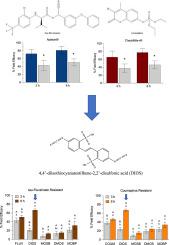当前位置:
X-MOL 学术
›
Pestic. Biochem. Phys.
›
论文详情
Our official English website, www.x-mol.net, welcomes your feedback! (Note: you will need to create a separate account there.)
Voltage-gated chloride channel blocker DIDS as an acaricide for Varroa mites
Pesticide Biochemistry and Physiology ( IF 4.7 ) Pub Date : 2020-07-01 , DOI: 10.1016/j.pestbp.2020.104603 Philene D Vu 1 , Leslie C Rault 2 , Lacey J Jenson 1 , Jeffrey R Bloomquist 3 , Troy D Anderson 2
Pesticide Biochemistry and Physiology ( IF 4.7 ) Pub Date : 2020-07-01 , DOI: 10.1016/j.pestbp.2020.104603 Philene D Vu 1 , Leslie C Rault 2 , Lacey J Jenson 1 , Jeffrey R Bloomquist 3 , Troy D Anderson 2
Affiliation

|
The Varroa mite is a primary driver behind periodical losses of honey bee colonies. These mites require honey bees for food and reproduction and, in turn, elicit physiological deficiencies and diseases that compromise colony health. Current acaricides for Varroa mite control, such as Apistan® (the pyrethroid tau-fluvalinate), CheckMite+® (the organophosphate coumaphos), and Apivar® (the formamidine amitraz) target the nervous system, can have adverse health effects on honey bees, and have limited effectiveness due to reported resistance issues. New target sites are needed to circumvent these obstacles in Varroa mite management, and voltage-gated chloride channels (VGCCs) are promising candidates due to their important role in the maintenance of nerve and muscle excitability in arthropod pests. Toxicological analysis of Varroa mites sensitive to tau-fluvalinate and coumaphos and Varroa mites with reduced sensitivity to these acaricides showed a significant increase in metabolic detoxification enzyme activities for the latter. Acetylcholinesterase activity in the Varroa mites exhibiting reduced mortality to coumaphos was significantly less sensitive to coumaphos-oxon compared to coumaphos-sensitive Varroa mites, which suggests target-site insensitivity to the acaricide. Voltage-gated chloride channel blocker DIDS had significantly greater field efficacy compared to Apistan® and CheckMite+® against Varroa mites from honey bee hives where tau-fluvalinate and coumaphos were observed to be ineffective, respectively. These data suggest that DIDS, and potentially other stilbene chemistries, might serve as candidates for continued field efficacy testing of alternative acaricides in apiaries where Apistan®- and CheckMite+® efficacy has been. reduced or lost for Varroa mites.
中文翻译:

电压门控氯通道阻滞剂 DIDS 作为瓦螨的杀螨剂
瓦螨是蜜蜂群周期性丧失的主要驱动因素。这些螨虫需要蜜蜂来觅食和繁殖,反过来又会引起损害群体健康的生理缺陷和疾病。当前用于控制瓦螨的杀螨剂,例如 Apistan®(拟除虫菊酯 tau-fluvalinate)、CheckMite+®(有机磷香豆磷)和 Apivar®(甲脒双甲脒)针对神经系统,会对蜜蜂产生不利的健康影响,并且由于报告的耐药性问题,效果有限。需要新的目标位点来规避瓦螨管理中的这些障碍,电压门控氯离子通道 (VGCC) 是有希望的候选者,因为它们在维持节肢动物害虫的神经和肌肉兴奋性方面具有重要作用。对 tau-fluvalinate 和香豆磷敏感的瓦螨和对这些杀螨剂敏感性降低的瓦螨的毒理学分析表明,后者的代谢解毒酶活性显着增加。与香豆磷敏感的瓦螨相比,对香豆磷死亡率降低的瓦螨中的乙酰胆碱酯酶活性对香豆磷-氧磷的敏感性显着降低,这表明目标部位对杀螨剂不敏感。与 Apistan® 和 CheckMite+® 相比,电压门控氯离子通道阻滞剂 DIDS 对来自蜜蜂蜂箱的瓦螨具有显着更高的现场效力,其中观察到 tau-fluvalinate 和香豆磷分别无效。这些数据表明 DIDS 和潜在的其他二苯乙烯化学物质,在 Apistan®- 和 CheckMite+® 功效一直存在的养蜂场中,可作为替代杀螨剂的持续现场功效测试的候选物。瓦螨减少或丢失。
更新日期:2020-07-01
中文翻译:

电压门控氯通道阻滞剂 DIDS 作为瓦螨的杀螨剂
瓦螨是蜜蜂群周期性丧失的主要驱动因素。这些螨虫需要蜜蜂来觅食和繁殖,反过来又会引起损害群体健康的生理缺陷和疾病。当前用于控制瓦螨的杀螨剂,例如 Apistan®(拟除虫菊酯 tau-fluvalinate)、CheckMite+®(有机磷香豆磷)和 Apivar®(甲脒双甲脒)针对神经系统,会对蜜蜂产生不利的健康影响,并且由于报告的耐药性问题,效果有限。需要新的目标位点来规避瓦螨管理中的这些障碍,电压门控氯离子通道 (VGCC) 是有希望的候选者,因为它们在维持节肢动物害虫的神经和肌肉兴奋性方面具有重要作用。对 tau-fluvalinate 和香豆磷敏感的瓦螨和对这些杀螨剂敏感性降低的瓦螨的毒理学分析表明,后者的代谢解毒酶活性显着增加。与香豆磷敏感的瓦螨相比,对香豆磷死亡率降低的瓦螨中的乙酰胆碱酯酶活性对香豆磷-氧磷的敏感性显着降低,这表明目标部位对杀螨剂不敏感。与 Apistan® 和 CheckMite+® 相比,电压门控氯离子通道阻滞剂 DIDS 对来自蜜蜂蜂箱的瓦螨具有显着更高的现场效力,其中观察到 tau-fluvalinate 和香豆磷分别无效。这些数据表明 DIDS 和潜在的其他二苯乙烯化学物质,在 Apistan®- 和 CheckMite+® 功效一直存在的养蜂场中,可作为替代杀螨剂的持续现场功效测试的候选物。瓦螨减少或丢失。



























 京公网安备 11010802027423号
京公网安备 11010802027423号